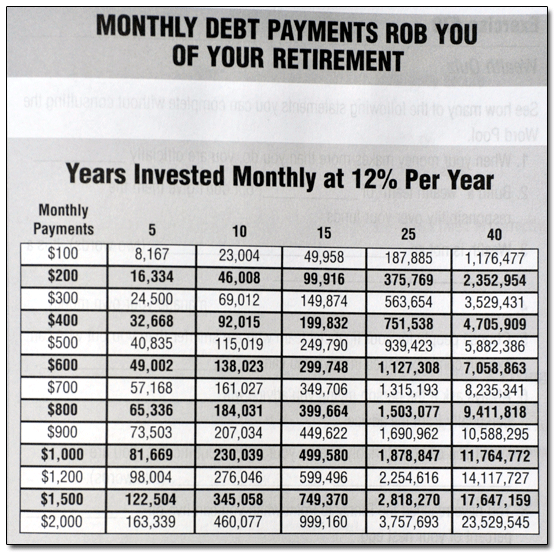When you have a website about personal finance that’s been up and running for years, you’re going to get plenty “Where do I start?” emails from readers.
It’s pretty much inevitable.
Same goes for your day-to-day life. As a financial blogger, if you develop any sort of “rep” at all, you’ll get similar questions from people you meet first-hand. The ones you don’t scare away, at least. You’re an Excel-wielding freak, after all.
Over the years, in these situations, I’ve become quite comfortable in my promotion of Dave Ramsey’s Baby Steps plan. The reason it became my first choice?
Simplicity, with a capital S.
Well, actually, that’s just the main reason I point folks toward the Baby Steps. The plan can, with minimal description necessary, fit on one page. Everyone grasps it, and grasps it quickly. In a world where smart personal finance is frequently nuked by eye-glazing jargon, fine print, and fast-talking brokers of every sort, “simple” is a big plus.
However, in my opinion, Ramsey’s Baby Steps plan is also the best-packaged (yes, this matters) and most accessible money plan out there.
Dave Ramsey himself often says (correctly) that there’s nothing new in what he preaches. Instead, he just “packages” it better than everyone else.
(He also has a mighty powerful, semi-captive “in” with the church-going crowd. But that’s a tangled post for another time.)
Don’t You Care About the Math?
Of course I care about the math. When I was working through my own “debt snowball,” I rerouted as many debt dollars into low-interest promo offers as I could, and then threw all extra cash at the highest-rate debts first. It worked great for us … but it also lengthened the time between instances where we could “cross debts off the list.”
In lieu of that, I had to find other ways to keep myself motivated and on track. Most of these had to do with creating It’s Your Money and Money Musings and writing as much as I could. And oh yeah — I read every financial book I could get my hands on.
Look: Paying debts off by smallest- to largest-balance, rather than by largest- to smallest-interest-rate, is practically guaranteed to cost more in interest. (Though how much more it’ll cost is very much a factor of how skyscraper-ish the rates are that you’re paying.)
What it does give you, though, is something that 98 percent of debtors I’ve encountered desperately need. And that something is near-term, rapid bursts of motivation. A sense of immediate progress. A way to look down and see that they are, in fact, moving forward. They’re marking creditors off the list.
It’s all about “quick wins,” as Ramsey phrases it.
I’ve given the pay-by-balance versus pay-by-rate battle a lot of thought. Once I account for human nature, I have to come down on the side of pay-by-balance. So on this facet, Dave and I agree … but lots of other money bloggers disagree.
Getting to Debt Freedom:
How Much Does The “How” Matter?
While it makes for interesting reader comments on higher-traffic blogs than this one, the “pay-by-balance” versus “pay-by-rate” debate seems, to me, to mostly miss the target:
If the plan you follow works — if it gets you out of debt, decreases your stress, and improves your life — then it was the right plan.
One More Reason I Recommend Dave…
It’s because he’s everywhere.
It comes down to that motivation thing again. If you’re feeling like you’re losing your grip on your finances, like your emergency fund saving and your debt paydown plans aren’t going anywhere, like your Baby Steps have become Baby Stumbles, then a few “visits with Dave” via his ubiquitous radio show and/or his nightly Fox Business call-in show can get your head straight in a hurry. And if you’re a Sunday-go-to-meetin’ soul, odds are pretty darn high that you’ll have a Financial Peace University setup going on there which you can easily access.
No other money guru is as accessible, as available in as many channels, as Dave Ramsey is right now. AM radio … TV … live events … books and DVDs … you name it. He’s there, and ready to smack you upside the head should the need arise. (Which it will.)
So there you go: In my mind, it’s the simplicity and accessibility of Dave Ramsey that puts him at the high-water mark of today’s financial personas.
Is he a salesman at heart? Absolutely he is.
Does he need to move DR-branded product? You bet he does.
But until someone else’s name starts popping up in the “My husband and I finally have our finances under control, and it’s all thanks to Dave Ramsey” statements I hear so often, his Baby Steps plan will be the one I suggest.



 Astute readers will notice that, as of the end of last month, Lisa and I reached our Liquid Savings Goal of $15,000. For the first time, that little green “Liquid Savings” bar chart on the right sidebar shows progress of one hundred percent.
Astute readers will notice that, as of the end of last month, Lisa and I reached our Liquid Savings Goal of $15,000. For the first time, that little green “Liquid Savings” bar chart on the right sidebar shows progress of one hundred percent.